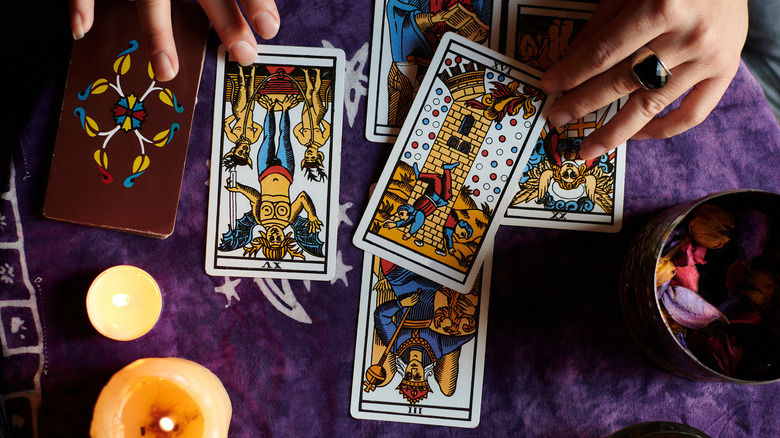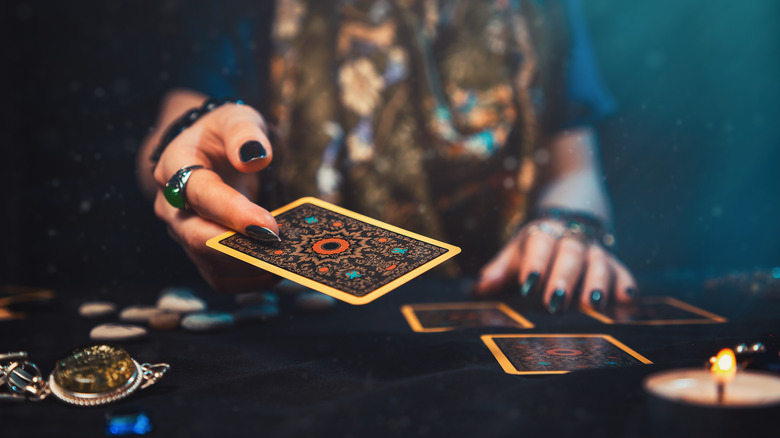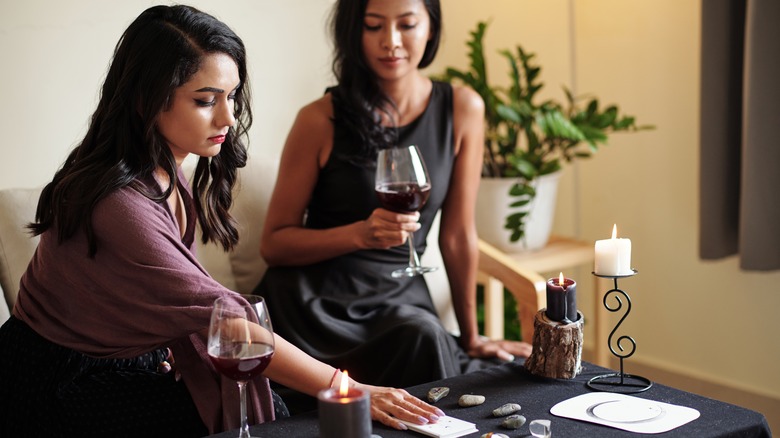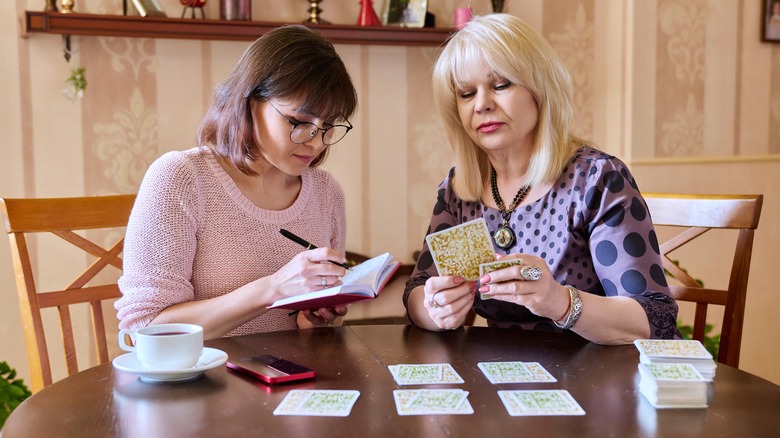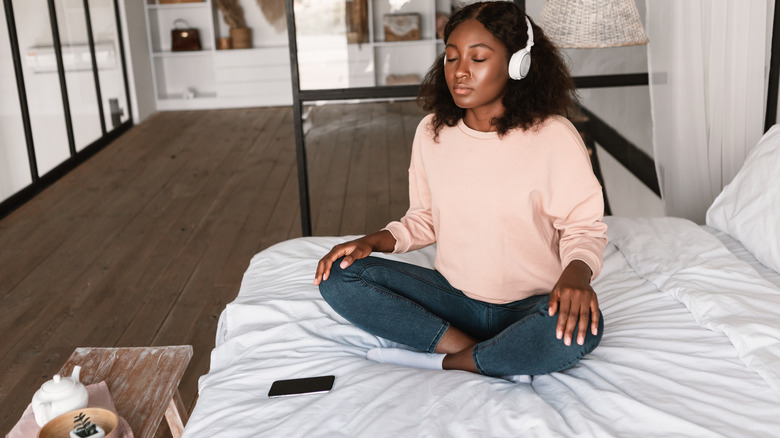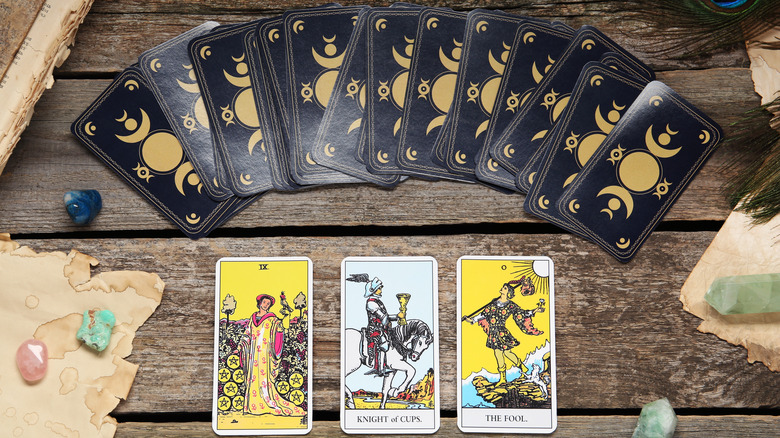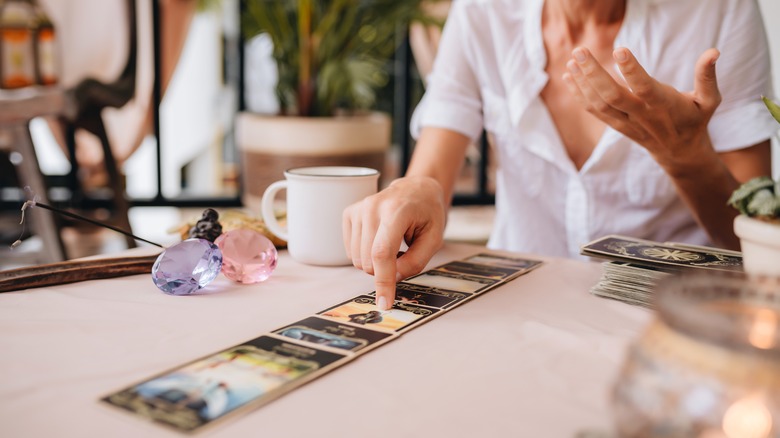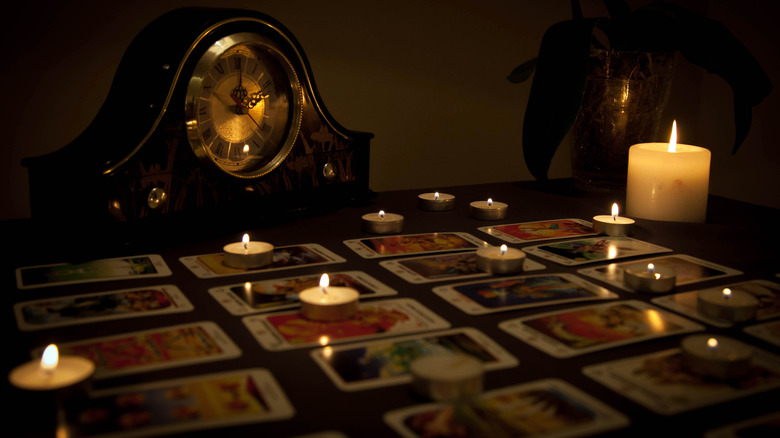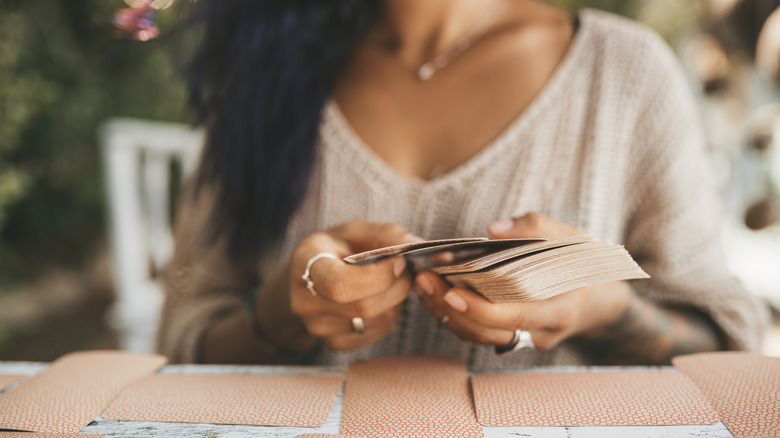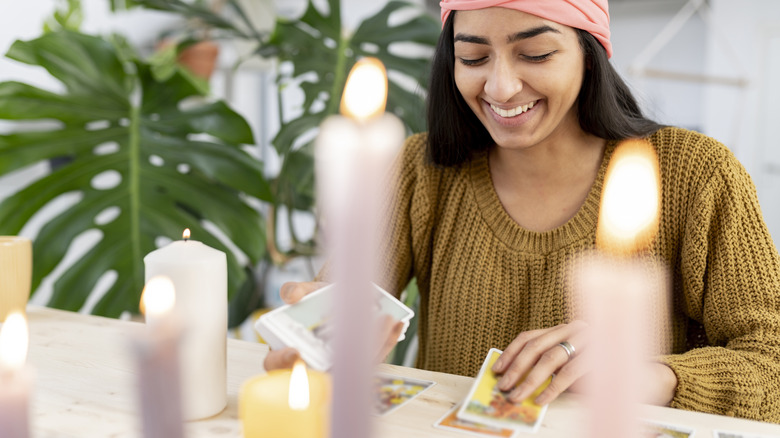Your Ultimate Guide To Preparing For A Tarot Card Reading
As each decade passes by, more and more people are tossing the old stereotypes of spiritual readings out the window — you know, the whole "wizened crone with a crystal ball, magic powers, and headscarf" bit. Because in reality, these types of readings aren't about diving into the dark arts or using supernatural abilities to predict when the next earth-shattering event on the news might occur; they should be seen more as self-help guidance sessions that can be used to help us dig deeper within ourselves. There are plenty of self-proclaimed psychics out there, and while some are certainly gifted with a higher sense of intuition and clarity, most readers rely heavily on the messages they have learned to read within a spread of tarot cards.
"It's a fabulous tool to use for self-reflection, like your heart or gut texting your head a message to explain something that sits below your consciousness," Emily McGill, professional tarot reader, explains to Bustle. "Think of it as a mirror that peers into the deeper parts of yourself and taps into the innate knowing that each spirit holds. It's an opportunity to explore things from a new perspective." In fact, though seeing a skilled tarot reader will give you a more in-depth experience, anyone can learn to read tarot cards and figure out how to decipher what messages they are trying to convey. But naturally, whether you're the one pulling the cards or you've left it up to the professionals, there are things you should be doing to emotionally and physically prepare yourself.
Ask yourself what you want out of your reading
Maybe you're just curious. Maybe you're there for fun, or you're genuinely in need of guidance. Whatever your reason, it's important to figure out exactly why you're even there in the first place. Typically, there's usually a deeper answer than what might appear on the surface. For example, if you've reluctantly agreed to tag along with friends, the fact that you even agreed to go might mean something. Perhaps there are things about your love life you've always wanted to know, or you're subconsciously in need of healing from your past. Writing out your feelings in a journal is a really great way to dive deeper within yourself and pinpoint exactly what you'd like out of your reading.
For many, tarot is a form of therapy. In fact, some even use tarot readings to holistically supplement their current mental health care routine, or alongside medication and seeing a counselor. "Sometimes, when people are anxious and depressed, it's a sign that their soul needs nurturing," notes New York-based author and tarot reader Cindi Sansone-Braff (via Healthline). "[Tarot is] a really good vortex for opening the subconscious mind and collective unconscious mind... and for figuring out what's going on below the surface."
So, before taking the plunge into the cards, be sure to carve out some time to figure out if a tarot reading may in fact mean something more to you than just a silly adventure while out with the girls — your mental health might thank you later.
Realize every reading is different
If this is your first time having a professional tarot card reading done, you'll soon realize that your reader likely has a specific way of doing things. If it isn't your first time, don't expect everything to be exactly the same as other times if you are visiting a different reader this time around. Some readers may ask you to choose a specific number of cards, while others may not have you choose a single card yourself at all. Some may have a policy that restricts them from discussing serious topics like health, pregnancy, or death, while some are more open to medical-related guidance. Ultimately, your reading will be an interpretation of the cards.
According to the spiritual advisor network Keen, all actions and thoughts are constantly changing; therefore, even the smallest decisions or factors can create a huge impact on the outcome of a situation. A chain of events like this is called the butterfly effect, and it is the main reason why no two tarot readings will ever be the same. "Tarot doesn't have any power over you," tarot reader Marguerite Gioia Insolia informs Today. "The reading is a timestamp of what's going on energetically around you, your circumstances, and what you're asking about," she continues. "People might walk out thinking they have no power or agency over these events in my life, but that's never true. You always have the ability to change how things are going to happen."
Have the right equipment prepared
Whether you're sitting down for a short and sweet 15-minute reading or you've blocked an hour out for an in-depth session, there's bound to be points brought up in the reading that don't make sense in the moment or that you'd like to reflect on later. Oftentimes, when we write things down from a reading, we tend to close the page and forget about it after some time. But by having those words on paper, you may discover that certain predictions or ideas from your reading did in fact come into fruition, sending you into an "Aha, it all makes sense now!" moment. Moreover, when we are in the reading itself, it can be quite easy to become engrossed in what's happening around us and forget to ask particular questions we had in mind; therefore, it's a great idea to bring a notebook filled out with pre-prepared questions, along with a pen for jotting notes down.
On the other hand, if you're doing the reading yourself, you may have to put in a little more work. Essentially, you will want to create a card reading space that feels authentic, safe, and like home. Find a tarot deck that speaks to you. Whether this means having a connection to the artwork on the cards or the messages written on each one, you'll want to be sure that this is a deck that provides you with a sense of peace and trust. Next, prepare the atmosphere with music, candles, incense, herbal tea, and of course, your pen and journal for notes.
Clear your mind with meditation
Tarot card readings are all about the energy that you pour into them. If you go into a reading with negative or blocked vibrations, your reader is likely to pick up on all of those forces and you'll end up with a less than accurate reading.
Meditation is an ideal way to clear away all of your negative blocks and put you in the right mental space for an insightful reading. To get the most out of meditation, you'll want to make sure you're in a quiet place that's free of all distractions. Lighting candles and incense, putting on soft music, and saging or smudging your space can all be very helpful to set the right mood.
If you're having a reading professionally done, this process can be done right before you head out for your appointment. If you're doing your reading at home, it's good to meditate right before you begin, following up with a card cleansing. To cleanse the deck, you can either use crystals or smoke from sage and incense, or leave it outside for 24 hours to draw in the energy from the sun and the moon.
Meditation is also great for clearing away any anxiety you may be feeling about your reading. If you are an anxious person, try sipping on lavender or chamomile tea before beginning your meditation session — the properties in each of these send relaxation signals to the brain without making you sleepy.
Study up on how tarot cards work
Going into a tarot card reading with absolutely no idea how tarot cards work is kind of like reading part two of a book before finishing the first one. You can sort of make sense of what's going on, but are you going to get the most out of it? With that being said, by no means should you put pressure on yourself to learn what each tarot card means before going into a professional reading; you simply should just know the basics. In fact, even if you are doing a spread yourself, there are many guides and tools to help you interpret things along the way.
First, put aside the notion that you'll be able to predict your, or anyone's, future from the cards. The 78 cards in a deck should be thought of as answers or pieces of information in regards to the lessons we need to learn for our own inner wisdom, strength, and manifestations. Each deck is split up into two sections: 22 Major Arcana cards that represent life's ultimate lessons, and 56 Minor Arcana cards that represent the issues and experiences we face day-to-day. Each card will mean something totally different depending on the other cards pulled with it, just as each interpretation will vary. Additionally, keep in mind that the cards should not be taken literally, so don't freak out if you pull a Death card — this simply means that a major life transition is coming your way as an old one closes.
Have questions ready
Some people go into a tarot reading with a plan to not say or ask anything at all; they do this to try and test out the "accuracy" of a reader by offering them as little information about themselves as possible. While this may seem like an intriguing idea, it's actually one of the worst situations you can put yourself in during a reading. Your cards and reader are going to depend a lot on the energy and information you're putting forth in order to give the best and most accurate reading possible. Since this is a service you're paying for, why not make the most of it and engage as much as you can?
The types of questions you go in with do matter, too. Yes or no questions can oftentimes place a dead-end scenario on your reading; instead, try to be as open-ended as possible. "Usually this means your question starts with a 'what' or 'how,'" tarot reader Ashley Collom tells Today. "For example, if someone wants to know, 'Am I going to get married to so-and-so?' The way to make that open-ended is, 'What do I need to know to enter a happy marriage with so-and-so?' It creates a more rounded-out conversation." Collom continues by sharing that time-related questions aren't always the best option either. Time is relative, so there isn't typically going to be a concrete answer to the timing of something. Moreover, time can create stress in our minds, and in turn affect outcomes.
Schedule yourself adequate time
Maybe you thought scheduling a tarot card reading with your girlfriends after dinner reservations sounded like a great time, or perhaps you're a busy mom who tried to squeeze in a reading right before your nail appointment. While there's nothing wrong with attempting to do other things on the day of your reading, always make sure you're giving yourself enough time before and after the reading to clear your mind, comprehend, and reflect. If you're rushing between appointments, you're going to create stress and anxiety within yourself, which is a huge day of reading no-no. Your reading should be treated just as if you were spending the day at the spa: a time to focus on yourself.
Moreover, many wonder about the best time of day to do a reading. Is it in the morning when you're feeling awake and refreshed and you've just had your coffee? Is it at night time when you've begun unwinding and you're ready to relax? The truth is, the best time to do a tarot card reading is when you feel the most energized, serene, and clear-minded, and naturally, this time will be different for different people. Some feel that the morning is when they have a fresh perspective on life, and by evening, their mind is cluttered with the trials and tribulations of the day. On the other hand, some people begin their day with worrisome thoughts about what's about to occur in the day ahead, so evening might be better for them.
Go into your reading with an open mind
If there's one thing that many tarot readers seem to agree upon, it's the single fact that the cards aren't perfect — and nor are its readers. It can be easy to place a lot of unrealistic expectations and false hopes in the cards, or you might go into a reading expecting to have a fantastic bond with your reader, which unfortunately isn't always the case. Because it's said that our free will is what ultimately decides our fate, it's important not to get too caught up and focused on what the cards say. In other words, go in with an open mind and take everything with a grain of salt, but apply the information to your life how you see fit.
Instead of using tarot as a fortune-telling tool, use it as an opportunity to embrace what is not known. Your reading can enhance your awareness in certain aspects of your life, highlight paths and outcomes that you may not have thought possible, help prevent mistakes, and give you deeper insight into things surrounding you that may be holding you back — but only if you are willing to receive this guidance with an open mind and no solid expectations.
Be present in the moment
When one amateur tarot reader asked professional reader Liz Worth, "I love reading tarot, but I don't always know how to connect to my querent's energy. Sometimes I feel like all of the messages in the cards are actually for me. How do I move past this?" Worth responded by sharing that the cards are simply a tool, and that it's up to the reader to take on the responsibility of interpreting them. She notes how important it is for a reader to have an understanding of what the specific purpose of the reading is before it even begins, and this can go for professionals or those who are doing their own spreads.
What does this mean for those having readings done by a professional? For the most part, it highlights just how essential it is for you to have your heart, mind, and energy focused on the cards. If you begin daydreaming about the meatloaf you're making for dinner or that big assignment you have due at work the next day during your reading, chances are your reader — as well as the cards — will to have a much more difficult time picking up on your vibrations, so always plan to be mentally present for your readings.
Prepare to do some talking
Because tarot is a fantastic complement to any type of counseling or therapy, it can actually give you even further insight into any emotions or situations you may be dealing with. But the only way to really access these deeper feelings is by communicating with your reader and letting things out. Remember: your reader is meant to be your ally, and they are there to guide and help you with the assistance of the cards. It might take a few appointments to get to the point where you feel comfortable sharing intimate details, but you should like and trust your reader enough to not fear dishing out what in the past may have hurt you, or what in the future scares or excites you.
"Tarot is really like a tool, a tool to facilitate talking about things," Rachel Howe, Brooklyn-based artist, Reiki healer, and tarot reader explains to Vogue. "Because there's this sort of added mystical energy to it or some sort of mystical connection, you can see people start to open up in a way that they might not if you were just having a conversation about something. There's something about the special energy about it that kind of melts away the walls that people have and then the conversation can really get in there and make changes."
